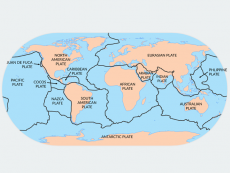

The 4 different types of plate boundaries
Destructive plate boundaries
Descriptive plate boundaries are found where two plates are moving together and oceanic plate material is destroyed. The collusion of the two plates buckles the leading edge of the continental plate forming fold margins. The magma rises through weaknesses, this is where the convection currents occur. Destructive plate boundaries can cause earthquakes and volcanoes. The convection currents cause the plate boundaries to hit each other.
Constructive plate boundaries
New basaltic materials rise to the surface which will cause the plates to force apart, that isa. Constructive plate. There are rising convection currents in the mantle drop temperature and spreads outwards when near the surface. This will cause the crust to break apart. This forms new crust.
Collision plate boundaries
In a collision plate, two continental plates move towards earth other due to convection currents, neither is destroyed but buckling will take place. Earthquakes occur a lot and no volcanoes are formed.
Conservative plate boundaries
Conservative plate boundaries occur when plates are sliding past one another. There is no plate being created or destroyed because there is no magma and no subduction. But the sliding is not smooth, there is friction between the plates and extreme stresses build up in the crustal rocks.
A volcano is formed from cracks in the crust- constructive plate
Types of volcanoes
The shape and structure of a volcano is related to the type of magma that created them
Basaltic magma
found on a constructive margin
High temperature that is very fluid
Low in silica and gas content
An example: Mauna Loa in Hawaii
Andesitic magma
found along destructive margins
Low temperature
High silica and gas
An example: Mount Pinatubo
Granitic magma
constructive or destructive (not so common)
Low temperature
High silica (thick and sticky)
Why does the volcano threat posted vary?
Mauna Loa is less of a threat than Mount Pinatubo because Mauna Loa has frequent eruptions so people adopt the lifestyle and are used to it and Mauna Loa is a richer country so they can therefore afford the repairs needed. Where as Mount Pinatubo having less frequent eruptions, that tend to be more explosive and more damaging, with less money, it is harder to repair. This means that when a volcanic eruption occurs, more damage occues.
Vulnerability- the higher chance of something happening to you, the more vulnerable you are
Not everyone is at risk of volcanic hazards, you essentially need to be near to a plate boundary.
Capacity- the ability of a community to absorb and recover from the effects of a natural hazard.
Primary effects of a volcanic eruption
impacts that take place at the time of the event
Destruction of homes
Death or injuries
Water contamination
Loss of communication
Land slides
Loss of wildlife and marine land fire
Secondary effects of a volcanic eruption
impacts that follow an event, these have an indirect impact
Economic decline
Formation of unstable layers of ash and lava
Climate change
Shortage of food and water
Homelessness
Tourism destroyed
Image- https://earthhow.com/7-major-tectonic-plates/

0 Comment:
Be the first one to comment on this article.